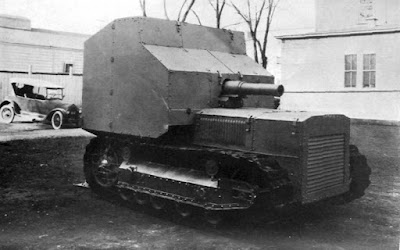 |
| Holt's Mark VI SPG mounting the 75 mm Gun M1920. |
Holt constructed two Mk. VI vehicles at their Stockton factory between 1920 and 1921. However, rather than basing these designs off their preexisting tractors, these vehicles were designed from the ground up. Similar to the competing design by Christie, these tanks were designed to mount either a short 75 mm gun or a 105 mm howitzer.
 |
| Holt's Mark VI SPG mounting the 105 mm Howitzer M1920. |
A surviving Mk. VI was on display at Aberdeen, Maryland, but it's now believed to be in storage at Fort Lee, Virginia.
 |
| The Mark VI with the 105 mm M1920 and the armored enclosure erected. |
In line with the rest of the Holt SPG branch, this tank should have above-average accuracy for its tier. This can be mitigated by giving it a poor reload speed and/or aim time. Armor on these "tanks", while unknown to me, should be practically nonexistent—even for something as commonly unarmored as an SPG.
Guns: 75 mm Gun M1920; 105 mm Howitzer M1920
Guns: 75 mm Gun M1920; 105 mm Howitzer M1920
Engines: Cadillac V8 (70 hp); Holt V8 (75 hp)
Suspensions/Alternate Hulls, Total Weight (metric tons): Holt Mark VI (5.9); Holt Mark VI shielded (6)
Hull Armor (mm): ??/??/??
Top Speed: 43 km/h
Crew: 4 (Driver; Gunner; Loader; Commander/Radio/Loader)
Parent: CMC 1920
Children: Holt Mk. X
See Also: Holt Mk. VII
Sources:
Parent: CMC 1920
Children: Holt Mk. X
See Also: Holt Mk. VII
Sources:
http://landships.info/landships/tank_articles.html?load=tank_articles/Holt_SPGs.html#
http://aviarmor.net/tww2/tanks/usa/spg_holt_mk6.htm


No comments:
Post a Comment